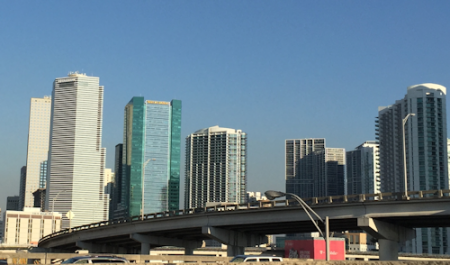As a young boy, I once noticed that our family dog would lie in the seemingly exact geometric center of the people in the house. Upon noticing this, I tested it by gathering the family together, then watching what he would do as people moved around the room. Even if someone moved just a couple of feet, he would move a few inches to what seemed to be a pretty good calculation of the new geometric center. Canine geometry. Wild.
 Development, likewise, tends to gravitate toward the middle of economic activity. Progress in areas north and west of Miami in recent years cause me to suspect this gravitational pull is increasingly to the north.
Development, likewise, tends to gravitate toward the middle of economic activity. Progress in areas north and west of Miami in recent years cause me to suspect this gravitational pull is increasingly to the north.
No so many years ago, as downtown Miami increasingly felt unwelcoming, even dangerous. Economic activity in the central business district shifted south of the river down Brickell Avenue. Of late, however, this trend is changing. The development of Miami Worldcenter, developments up Biscayne Boulevard and into Edgewater, point toward a steady shift north. Add to this developments like America Dream Miami in Miami Lakes, Doral City Place and numerous other projects in Doral, and ever increasing development activity up to, and especially including, Fort Lauderdale, and the shift becomes more distinct.
This all makes sense, when considered. The economic center should be, well, in the economic center. And, as much as Miami can seem like a Singapore-esque city state island on a alligator owned isthmus, the truth is economic activity abounds in relatively nearby metropolises, none of which are to the south, and these (nearby metropolises) are all growing themselves. It is only natural for Miami’s economic center to shift toward the middle of this activity. This is plainly evident when viewing South Florida from above. Miami is the southern end of a strip of urbanization, a long strip of pavement, if you will, with other pockets to the direct west and north:
Fort Lauderdale is in the middle of its own development surge. As it becomes more of an economic powerhouse in its own right, economic ties between the two large cities are bound to become increasingly stronger. Businesses will begin to recognize the benefit of being in one city, but on the way to the other.
The deep dredging of the port, and the Port of Miami tunnel, made Miami a more likely destination of cargo. Which way is that cargo going? Ever hear of a container of anything going to Key West? Me neither. Cargo goes north, with economic activity following its route. All Aboard Florida may be another driving force. The train goes north out of Miami, not south, recognizing downtown Miami as the most southerly hub of a set of destinations.
Naples, Fort Myers, Orlando, and Tampa are all accessible to the west or the north. These are all perhaps far enough away to have less of an economic gravitational pull, but they pull a touch, nonetheless, and none of them are pulling south.
So what are the possible implications of this? To be sure, Miami is hot, as is all of South Florida. As much as many expect “the shoe to drop” any day, this boom feels fundamental, less credit driven, more preference/demand driven. Thus, it would seem unwise to start questioning the prospects of any area in South Florida. North of Miami, however, lie large areas that have not felt the boom as much as the rest of the area, including some of the areas largest areas of economic blight. It would seem that significant opportunities may be found within these areas.
